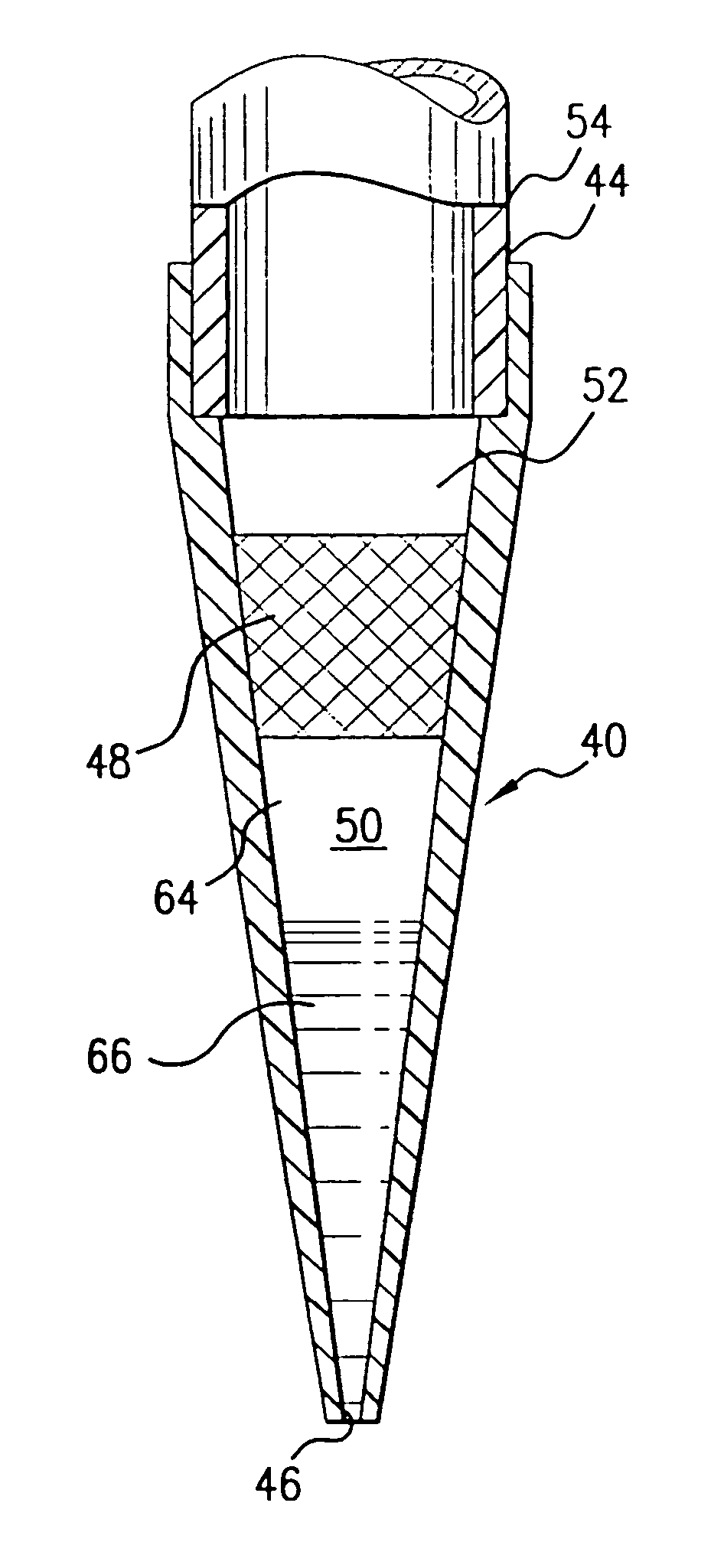Self-sealing materials and devices comprising same
a self-sealing material and liquid-permeable technology, applied in the field of gas-permeable materials, can solve the problems of cellulose powder leaching of metal or other ions, too slow to be of much use in other applications,
- Summary
- Abstract
- Description
- Claims
- Application Information
AI Technical Summary
Benefits of technology
Problems solved by technology
Method used
Image
Examples
example 1
5.1. Example 1
Synthesis of Hydrophilic Polyurethane
[0080] A reaction flask was gently warmed to 30.degree. C. -40.degree. C. under a nitrogen atmosphere using a heating mantle with a temperature indicator. 100 g of 4.4'-diphenylmethane (Aldrich) diisocyanate were fed into the reactor. The flask was then heated to 80.degree. C. as the contents were stirred. After the temperature was stable, 1,000 g of PEG-1000 (Aldrich) were added to the reactor. A transparent viscous gel was formed after 10 minutes of stirring, at which time 19.6 g of butanediol (Aldrich) were added to the reaction mixture. The mixture was stirred for an additional 2 minutes while the temperature was maintained at about 85.degree. C. The resulting hot viscous gel was then poured into a metal mold, which was then placed in an oven maintained at about 65.degree. C. for 6 hours. The resulting product was removed from the mold and fed through a twin-screw extender maintained at 85.degree. C. to provide hydrophilic polyu...
example 2
5.2. Example 2
Preparation of Self-Sealing Material
[0082] Porous ultra high molecular weight polyethylene having an average pore size of 20 to 35 .mu.m (Porex Technologies Corp.) was dipped in an ethanol solution containing 20 percent by weight hydrophilic polyurethane prepared according to Example 1. The porous substrate was kept in the solution for about 5 minutes and then removed and dried first under blowing hot air and then in a conventional oven kept at 65.degree. C. for 2 hours.
example 3
5.3. Example 3
Properties of Self-Sealing Materials
[0083] Self-sealing materials prepared from ultra high molecular weight polyurethane as in Example 2 exhibit different air flow and back-pressure properties depending on the pore size of the substrate material and the concentration of the hydrophilic polyurethane solution in which it was dipped, as shown below in Tables 1 and 2:
1TABLE 1 Airflow Rate (ml / min) under an Air Pressure of 1.2 Inches Water Coating Solution Airflow rate (ml / min) Concentration 10 (.mu.m) (weight percent) pore size 25 (.mu.m) pore size 35 (.mu.m) pore size 0 10 28 29 10 8.0 20 25 15 7.0 18 19 20 6.8 16.2 16
[0084]
2TABLE 2 Water Back Pressure (psi) Coating Solution Water back pressure (psi) Concentration 10 (.mu.m) 25 (.mu.m) 35 (.mu.m) (weight percent) pore size pore size pore size 0 3 2 1.5 10 >7 >7 3.5 15 >7 >7 6.0 20 >7 >7 >7
[0085] Because perfect sealing typically occurs at about 7 psi, it is clear from Table 2 that self-sealing materials can be provided us...
PUM
| Property | Measurement | Unit |
|---|---|---|
| back-pressures | aaaaa | aaaaa |
| pressure | aaaaa | aaaaa |
| pressure | aaaaa | aaaaa |
Abstract
Description
Claims
Application Information
 Login to View More
Login to View More - R&D
- Intellectual Property
- Life Sciences
- Materials
- Tech Scout
- Unparalleled Data Quality
- Higher Quality Content
- 60% Fewer Hallucinations
Browse by: Latest US Patents, China's latest patents, Technical Efficacy Thesaurus, Application Domain, Technology Topic, Popular Technical Reports.
© 2025 PatSnap. All rights reserved.Legal|Privacy policy|Modern Slavery Act Transparency Statement|Sitemap|About US| Contact US: help@patsnap.com



